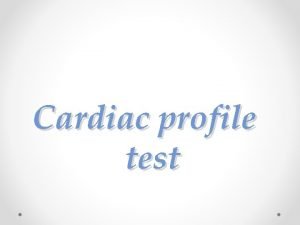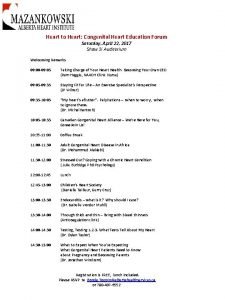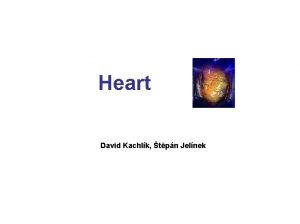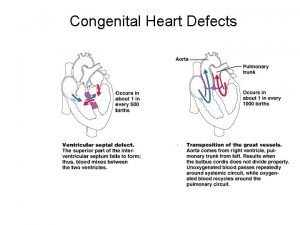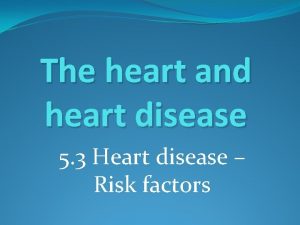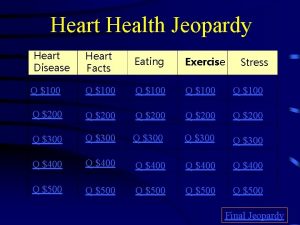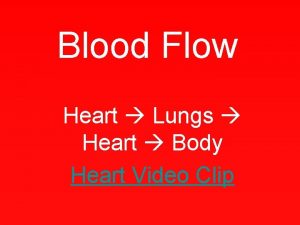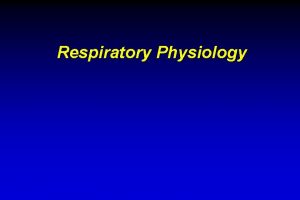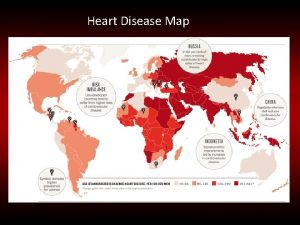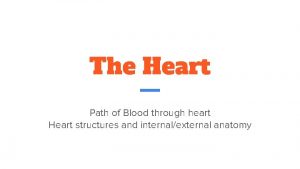Heart profile Human heart What Is the Heart





























- Slides: 29

Heart profile

Human heart What Is the Heart? the heart is a muscular organ that pumps blood to the body. heart is at the center of the circulatory system. An electrical system controls the heart and uses electrical signals to contract the heart's walls. When the walls contract , blood is pumped into the circulatory system. Inlet and outlet valves in the heart chambers ensure that blood flows in the right direction.

Human heart. the heart is vital to our health and nearly everything that goes on in our body. Without the heart's pumping action, blood can't move throughout your body. healthy heart supplies our body with the right amount of blood at the rate needed to work well. If disease or injury weakens our heart, the body's organs won't receive enough blood to work normally.

Heart structure the circulatory system or cardiovascular system consist of the heart and blood vessels, the heart is the key organ in the circulatory system. The volume of the heart like size of our fist is almost located between the lungs on the left side. 1)Heart contains four hollow spaces called champers: left atrium the right atrium the left ventricle the right ventricle

Heart structure 2)blood vessel: a vessel is defined as a hollow container for carrying • something: a cup, a bucket, a tube. Blood vessels, then, are hollow container for carrying blood. Located throughout the body. There are three varieties of blood vessels: arteries, veins, and capillaries. • During blood circulation, the arteries carry blood away from the heart. The capillaries connect the arteries to veins. Finally, the veins carry the blood back to the heart.

heart function the primary function of the heart is to pump blood throughout the body. The regular and continuous contracting of heart muscle, myocardium, generates and sustains an arterial blood pressure necessary to provide adequate perfusion of organs. •

heart profile The major heart test that do on the clinical laboratory is 1)lactate dehydrogenize(LDH) 2) creatine kinase (ck. ck-mb) 3)tropinin 1

Lactate dehydrogenase This enzyme catalyzes the reversible reaction between pyruvic and lactic acids. The lactate dehydrogenase (LDH) test measures the amount of LDH in the blood LDH is most often measured to check for tissue damage. The enzyme LDH is in many body tissues, especially the heart, liver, kidney, skeletal muscle, brain, blood cells, and lungs so LDH can be found in many tissues in the body, total LDH is not specific for heart disease.

Lactate dehydrogenase LDH exists in 5 forms, which differ slightly in structures • LDH-1 is found primarily in heart muscle and red blood cells. • LDH-2 is concentrated in white blood cells. • LDH-3 is highest in the lung. • LDH-4 is highest in the kidney, placenta, and pancreas. • LDH-5 is highest in the liver and skeletal muscle. All of these can be measured in the blood A typical range is 105 - 333 IU/L

Creatine Kinase – CK enzyme present in high concentration in the cytoplasm of myocytes and is the most widely used enzyme for evaluation of neuromuscular disease. In muscles, this enzyme functions by making ATP available for contraction by the phosphorylation of ADP from creatine phosphate by catalyzing the reversible phosphorylation of creatine by ATP to form phosphocreatine + ADP. Phosphocreatine is the major storage form of high energy phosphate in muscle

Creatine kinase There are four principle isoenzymes of CK: 1 -CK-1: BB isoenzyme, found mostly in the brain 2 -CK-2: MB isoenzyme, highest concentration in cardiac muscle, with lesser amounts in skeletal muscle 3 -CK-3: MM isoenzyme, found in skeletal muscle, with lesser amounts in cardiac muscle 4 -CK-Mt: Found in mitochondrial membranes, and comprises 15% of total cardiac CK activity.

Creatine kinase-mb The creatine kinase-MB fraction (CK-MB) is part of total CK and more specific for cardiac muscle that other striated muscle. It tends to increase within 3 to 4 hours of myocardial necrosis, then peak in a day and return to normal within 36 hours. It is less sensitive than troponins Total Creatine Kinase (Total CK)Normal Value: 38 -120 ng/ml Creatine Kinase-MB (CK-MB)Normal Value: 0 -3 ng/ml

Troponin 1 • Troponin I and T are structural components of cardiac muscle. They are released into the bloodstream with myocardial injury. They are highly specific for myocardial injury--more than CK-MB--and help to exclude elevations of CK with skeletal muscle trauma. Troponins will begin to increase following within 3 to 12 hours, about the same time frame as CK -MB • Normal Value: <0. 4 ng/ml

Lactate dehydrogenase LDH is most often measured to check for tissue damage. The enzyme LDH is in many body tissues, especially the heart, liver, kidney, skeletal muscle, brain, blood cells, and lungs A typical range is 105 - 333 IU/L (international units per liter Lactate dehydrogenase is an enzyme that catalyzes the conversion of lactate to pyruvate. It is not tissue-specific, being found in a variety of tissues, including liver, heart and skeletal muscle

Elevated LDH levels : 1 - Hemolysis; serum has higher levels than plasma as the enzyme is released from cells during clotting. . 2 - Physiologic: Exercise 3 -Liver disease: Increased LDH 1 and LDH 2 4 -Muscle disease: Increased LDH 5 .

Lactate dehydrogenase Higher-than-normal levels may indicate 1 - Heart attack 2 -Hemolytic anemia 3 -Liver disease (for example, hepatitis) 4 -Low blood pressure 5 - Muscle injury 6 -Pancreatitis 7 -Tissue dead

Hemolytic anemia is a condition in which there are not enough red blood cells in the blood, due to the premature destruction of red blood cells • Causes Hemolytic anemia occurs when the bone marrow is unable to increase production to make up for the premature destruction of red blood cells. ).

Creatine Kinase – CK CK has a very short half life, < 1 hour in horses. Activity increases quickly (peaks at 6 -12 hours) and returns to normal within 24 -48 hours Total Creatine Kinase (Total CK)Normal Value: 38 -120 ng/ml Creatine Kinase-MB (CK-MB)Normal Value: 0 -3 ng/ml • The creatine kinase-MB fraction (CK-MB) is part of total CK and more specific for cardiac muscle

Causes of increased CK 1 -Physiologic: CK values in young puppies are higher than in adults 2 -· Muscle disease: Detection of increased activity in serum is useful as an indicator of muscle injury. 3 -Artifact: Hemolysis will increase CK values as analytes in red blood cellsor their membranes (adenylate kinase) contribute to the enzymatic reaction for CK, artifactually increasing values.

Creatine Kinase • Creatine Kinase (CK): Unexpectedly High • Asymptomatic high CK: General – More common in males than females – May occur at all ages

heart attack A heart attack occurs when blood flow to a part of your heart is blocked for a long enough time that part of the heart muscle is damaged or dies. caused by a blood clot that blocks one of the coronary arteries. The coronary arteries bring blood and oxygen to the heart. If the blood flow is blocked, the heart is starved of oxygen and heart cells die

Creatine Kinase (CK): Low • Muscle disease • Hyperthyroidism • Multiorgan failure Rheumatic diseases: Active inflammation •

Troponins Troponin Normal Value: <0. 4 ng/ml highly specific for myocardial injury-more than. CK-MB Troponins will begin to increase within 3 to 12 hours, about the same time frame as CK-MB

Ischaemic Heart Disease, otherwise known as Coronary Artery Disease, is a condition that affects the supply of blood to the heart. The blood vessels are narrowed or blocked due to the deposition of cholesterol plaques on their walls. This reduces the supply of oxygen and nutrients to the heart musculature, Ischemic heart disease is caused by an imbalance between the myocardial blood flow and the metabolic

Laboratory Procedure Manual Analyte: Lactate Dehydrogenase • Matrix: Refrigerated Serum • Method: Beckman Synchron LX 20 •

TEST PRINCIPLE The LX 20 with LD reagent (using lactate as substrate) utilizes an enzymatic rate method to measure LD activity in biological fluids. In the reaction, the LD catalyzes the reversible oxidation of L-Lactate to Pyruvate with the concurrent reduction of ß-nicotinamide adenine dinucleotide (NAD) to ß-nicotinamide adenine dinucleotide hydroxylase (reduced form; NADH). The system monitors the rate of change in absorbance at 340 nm over a fixed time interval. The rate of change in absorbance is directly proportional to the activity of LD in the sample

references http: //www. student. med. umn. edu/wardmanual/normallabs. php • http: //library. med. utah. edu/Web. Path/TUTORIAL/MYOCARD. h • tml http: //ahdc. vet. cornell. edu/clinpath/modules/chem/ck. htm • http: //www. nlm. nih. gov/medlineplus/ency/article/003471. htm • http: //neuromuscular. wustl. edu/lab/cknomyo. html • http: //www. fi. edu/learn/heart/history. html • http: //www. nhlbi. nih. gov/health-topics/hhw/ http: //www. cdc. gov/nchs/data/nhanes_03_04/l 40_c_met_lactate_d ehydrogenase. pdf http: //www. med. uc. edu/kranias/cardiac_function. htm

By: rahaf babgi Alaa alamoudi

 Sheep heart vs human heart
Sheep heart vs human heart Hát kết hợp bộ gõ cơ thể
Hát kết hợp bộ gõ cơ thể Bổ thể
Bổ thể Tỉ lệ cơ thể trẻ em
Tỉ lệ cơ thể trẻ em Gấu đi như thế nào
Gấu đi như thế nào Chụp phim tư thế worms-breton
Chụp phim tư thế worms-breton Chúa sống lại
Chúa sống lại Các môn thể thao bắt đầu bằng tiếng bóng
Các môn thể thao bắt đầu bằng tiếng bóng Thế nào là hệ số cao nhất
Thế nào là hệ số cao nhất Các châu lục và đại dương trên thế giới
Các châu lục và đại dương trên thế giới Công thức tính độ biến thiên đông lượng
Công thức tính độ biến thiên đông lượng Trời xanh đây là của chúng ta thể thơ
Trời xanh đây là của chúng ta thể thơ Cách giải mật thư tọa độ
Cách giải mật thư tọa độ Phép trừ bù
Phép trừ bù độ dài liên kết
độ dài liên kết Các châu lục và đại dương trên thế giới
Các châu lục và đại dương trên thế giới Thể thơ truyền thống
Thể thơ truyền thống Quá trình desamine hóa có thể tạo ra
Quá trình desamine hóa có thể tạo ra Một số thể thơ truyền thống
Một số thể thơ truyền thống Cái miệng xinh xinh thế chỉ nói điều hay thôi
Cái miệng xinh xinh thế chỉ nói điều hay thôi Vẽ hình chiếu vuông góc của vật thể sau
Vẽ hình chiếu vuông góc của vật thể sau Nguyên nhân của sự mỏi cơ sinh 8
Nguyên nhân của sự mỏi cơ sinh 8 đặc điểm cơ thể của người tối cổ
đặc điểm cơ thể của người tối cổ Ví dụ giọng cùng tên
Ví dụ giọng cùng tên Vẽ hình chiếu đứng bằng cạnh của vật thể
Vẽ hình chiếu đứng bằng cạnh của vật thể Phối cảnh
Phối cảnh Thẻ vin
Thẻ vin đại từ thay thế
đại từ thay thế điện thế nghỉ
điện thế nghỉ
































